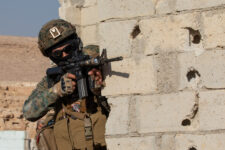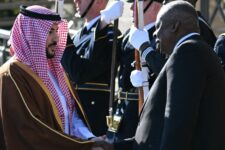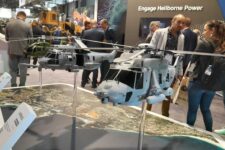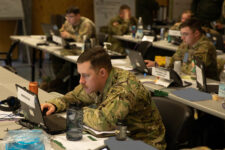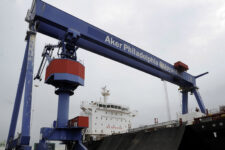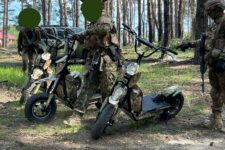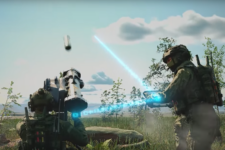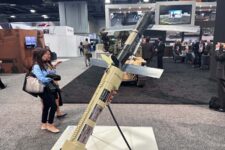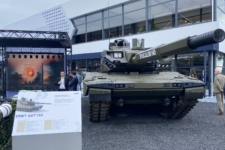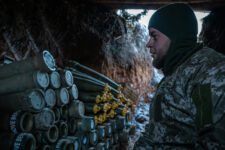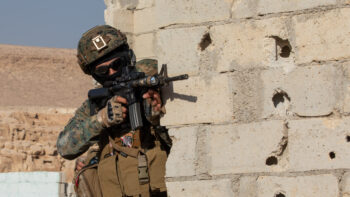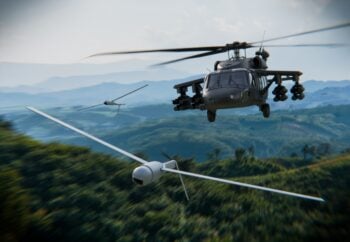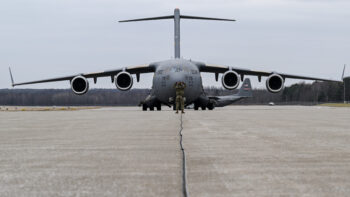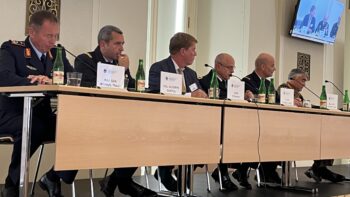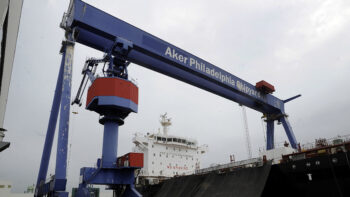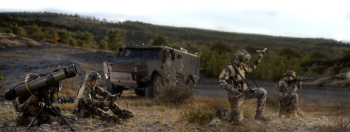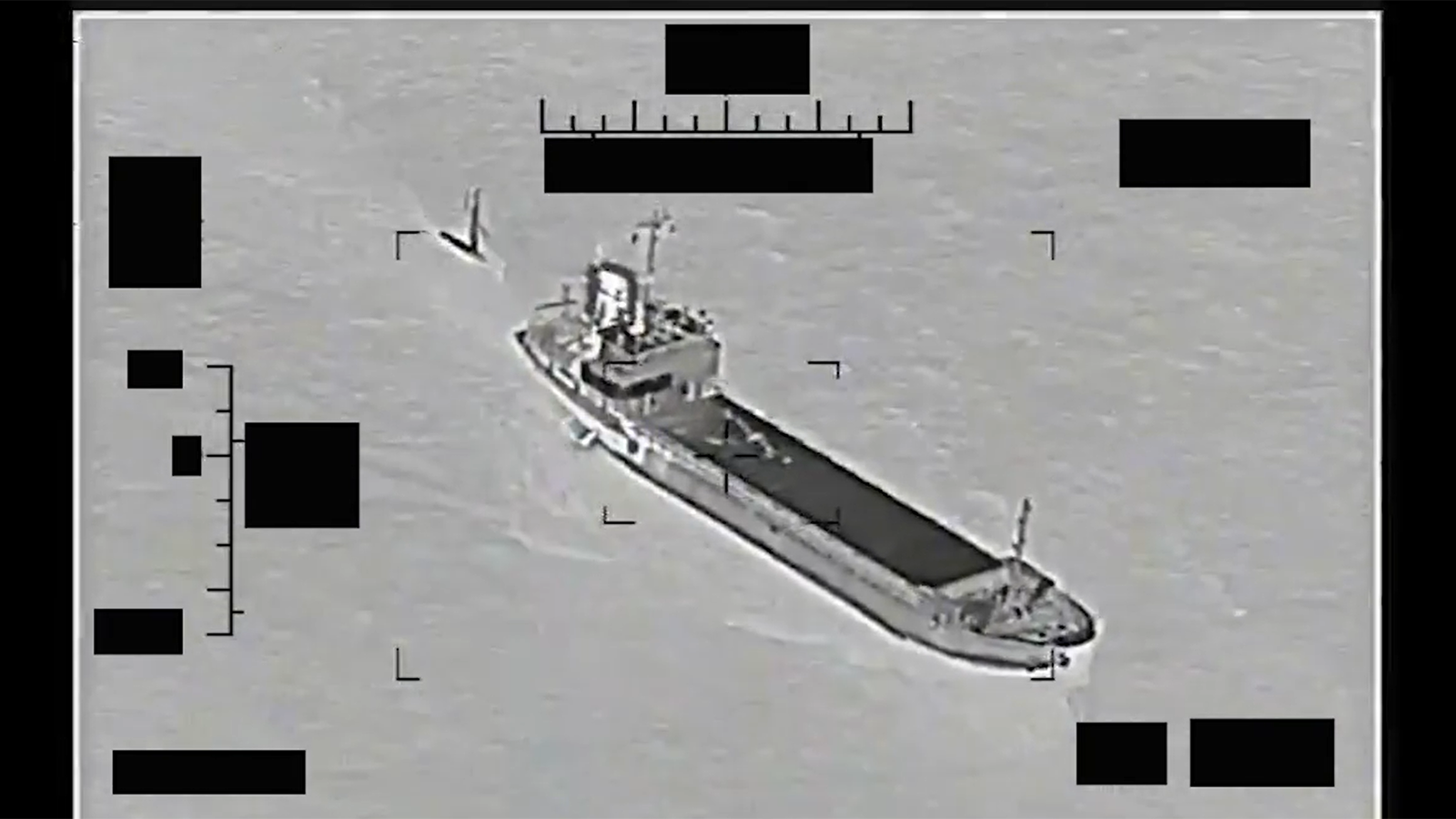
A screengrab from a video showing support ship Shahid Baziar, from Iran’s Islamic Revolutionary Guard Corps Navy unlawfully towing a Saildrone Explorer unmanned surface vessel in international waters of the Arabian Gulf on Aug. 30, 2022. (U.S. Navy video)
WASHINGTON — Iran’s regional influence has emerged as a focal point at the US-Gulf Cooperation Council (GCC) meeting in Riyadh this week, while members are also interested in the flow of weapons from Tehran to Moscow, according to a top Pentagon official participating in the ongoing meetings.
Three US-GCC working groups, made up of officials from the US and throughout the region, are expected to meet between Feb 13-16 to discuss topics like Iran and counterterrorism, creating a common air defense picture and maritime security, Deputy Assistant Secretary of Defense for the Middle East Dana Stroul told reporters today.
“What’s very clear to the US, and what is very clear to our partners, is that the threats of today, and the threats of tomorrow, do not respect borders, and therefore call for updating and upgrading how we partner together,” Stroul said.
“Whether it’s the proliferation of unmanned aerial vehicles, UAVs, illicit trafficking of weapons and drugs, and the arming, training and equipping of lethal aid to non-state actors… all of these call for multilateral cooperation and enhanced collective defense,” she added.
The US-GCC members — Bahrain, Kuwait, Oman, Qatar, Saudi Arabia, and the United Arab Emirates — in the past have condemned Iran’s “malign behavior through proxies”, in part, because of Tehran’s weapon shipments to Houthis in Yemen, a group also known as Ansar Allah. (Saudi Arabia launched a military campaign against the Iranian-backed Houthis in 2015 and has since been hit by inbound missiles and drones, as has the United Arab Emirates).
Stroul said US-GCC members are again discussing Iran’s activities in the region, while also examining Iran and Russia’s growing defense relationship. US officials have accused Tehran of supplying unmanned drones to Moscow, which have been used to attack civilian targets in Ukraine.
“We have seen no change in Iranian willingness or activities to transfer weapons to the Houthis despite their work with increasing military cooperation with Russia,” Stroul said. While there has been a decrease in Houthi attacks against Saudi Arabia, she attributed that to the now-expired truce.
RELATED: Iran made ‘big mistake’ in giving drones to Russia for Ukraine war, UK minister says
“A major concern that we all have to watch very closely is that the Houthis actually use the time of the truce to reset and rearm their forces,” she said.
The Skies Above And Water Below
In addition to looking at the cross section between Iran and counter-terrorism in the region, this week US-GCC members are looking to work more closely on information and technology sharing related to detecting and downing incoming ballistic missile, cruise missile and UAVs threats.
“There are some technical challenges to being able to share that [but] ultimately it’s really an authority and a desire to share [information] because even if we don’t have a technical ability to share an air [threat] digitally, we can at least pick up a phone and relay that there is a threat inbound,” explained Maj. Gen. Clark Quinn, the deputy commander of Ninth Air Force (Air Forces Central).
While Quinn contends that the group is making “small,” “concrete steps” forward, like hosting a regional air chief meeting last month, he also acknowledged that there is still not a firm plan that “gets us to a flip of a switch that we now have integrated air and missile defense.”
As talks continue about patrolling the regional skies above, when it comes to the waters below, Vice Adm. Brad Cooper, the commander of US Naval Forces Central Command (NAVCENT), US 5th Fleet, did not detail specific topics up for discussion this week but said the group plans to examine progress and identify opportunities for future collaboration.
For example, over the past two months, Cooper said partners have conducted five major interdictions at sea and seized more than 5,000 weapons, 1.6 million rounds of ammunition, 7,000 proximity fuses for rockets, over 2,000 kilograms of propellant, and $60 million worth of illegal drugs. However, he did not provide details about those specific incidents or where the shipments were headed.
“Everything we’ve accomplished… is a direct result of great work our maritime forces are doing really in two key areas, strengthening partnerships and accelerating innovation,” he said.
Cooper also noted NAVCENT’s September 2021 standing up of Task Force 59, designed to better integrate unmanned systems and artificial intelligence. Over the past year-and-a-half, Cooper said Task Force 59 has conducted 15 unmanned exercises with international partners where they integrate drones at sea with cameras, sensors and radar. As a result, he said it has enabled the nations to put “more eyes” out on the regional waters to better monitor what’s happening, and provide an enhanced level of deterrence.
RELATED: Iranian ship intercepted while trying to detain American maritime drone
Looking towards the end of the year, Cooper said he still wants to see a fleet of 100 unmanned surface vessels (USVs) in the regional waters.
“Our partners really do see the incredible opportunity to strengthen our collaboration and see by building toward a common operating picture,” Cooper added. “The integration of these autonomous platforms and sensors, alongside our cruise ships will enhance this capability.”
France would support Lebanese Armed Forces in southern border security mission: Official
A French official told Breaking Defense that Paris “must be ready” to aid Beirut should it attempt a historic deployment to secure Lebanon’s southern border, where Hezbollah could play spoiler.
